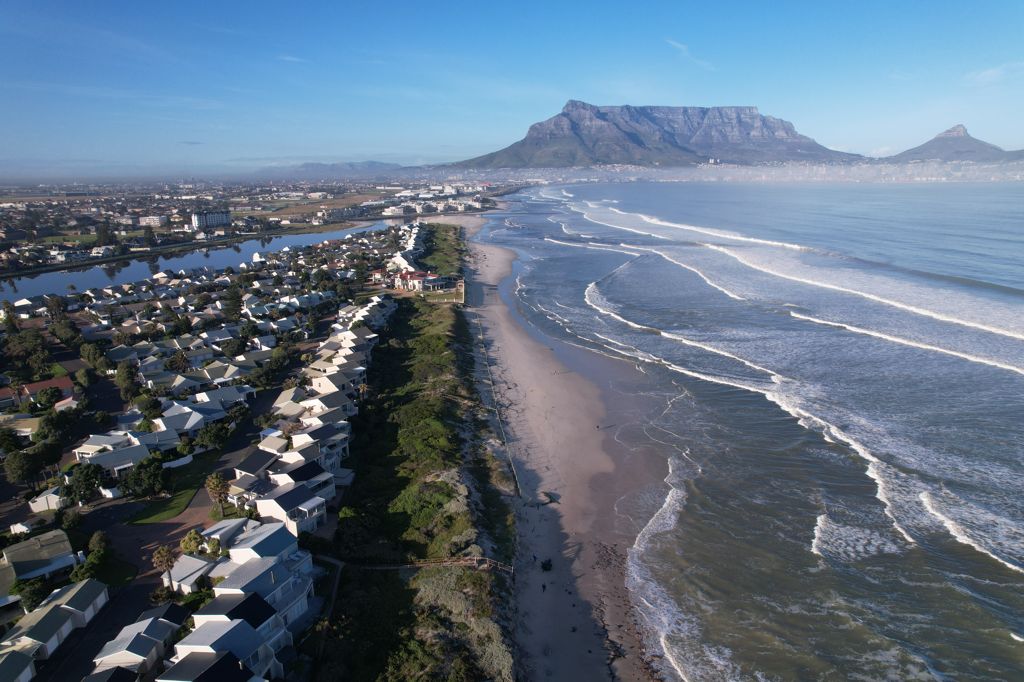Discovering the Intricacies of Coastal Erosion and Cusps on Cape Town’s Famous Beaches
Cape Town’s stretch of Atlantic shoreline, from Lagoon Beach to Sunset Beach, including Milnerton, boasts breathtaking landscapes with immaculate sandy beaches. Yet, these beaches face a slow retreating or erosion process over time. The complex interactions between sediment transport processes and urban development result in reduced sand replenishment during summer months, causing an overall loss and coastal erosion.
Although seemingly worrisome at first, coastal erosion is a natural occurrence that amplifies during Cape Town’s stormy winter season, forming coastal cusps. These unique indentations and protrusions along the open sandy coastlines add to the captivating sediment dynamics of this region.
In the past ten days, remarkable coastal cusps have appeared between Lagoon Beach and Sunset Beach, causing a significant decrease in beach levels and subsequent erosion of neighboring dunes. This event, already present on an eroding coastline, has brought about visually impactful changes to the shoreline.
The Importance of Coastal Cusps and the Effects of Erosion Incidents
Understanding the formation of coastal cusps is crucial for comprehending the sediment dynamics of the region and their role in increasing erosion at specific locations. One notable event occurred recently when back-to-back erosion incidents, combined with high spring tides, large waves, and a storm event, led to a concentrated, localized loss of sand, undermining the dunes and causing structural damage.
The last known event of this nature took place in July 2018, which similarly led to widespread beach erosion and structural damage to the Milnerton Surf Life Saver Club, the Milnerton Golf Club and Restaurant, and other local spots along the coast. In the interim between winter storms, the beaches experience a slow recovery process, during which new cusps may develop.
Deputy Mayor and Mayoral Committee Member for Spatial Planning and Environment, Alderman Eddie Andrews, provided insight on the situation, explaining that this natural coastal process happens alongside gradual erosion. When it encounters fixed infrastructure, the striking images we see along parts of the coastline emerge as a consequence.
In certain areas, the low beach levels have unveiled a hidden geological layer, exposing ancient shell and pebble layers believed to prevent further beach erosion. Often mistaken for oil spills or dumped material, these dark, soft brown and red rock layers serve as tangible evidence of Cape Town’s captivating coastline’s geological history.
Appreciating Nature’s Beauty and Complexity Through Coastal Erosion
Cape Town’s Atlantic coastline’s recent coastal erosion offers a glimpse into nature’s intricate beauty and complexity. By understanding and valuing these natural processes, we can better assess the impact of urban development and modify our practices to preserve Cape Town’s fragile coastal ecosystems.
The striking visuals of the coastline’s transformation serve as reminders of nature’s power and unpredictability. They disclose the hidden geological wonders beneath our feet and offer an opportunity to connect with the rich history and dynamic environmental processes that shape our shores.
In a world defined by ceaseless change, these glimpses into the past and the constantly evolving natural processes remind us of the critical need for sustainable living and environmentally conscious urban planning. By recognizing the natural beauty and vulnerability of our coastlines, we can strive to ensure the preservation of these awe-inspiring landscapes – adorned with coastal cusps, ancient geological layers, and pristine beaches – for future generations to admire and learn from.
As we navigate modern life’s intricacies and continue to develop our societies, it is crucial to remain aware of the delicate balance between human interaction and the environment. The coastal cusps and erosion along Cape Town’s Atlantic coastline serve as a poignant reminder of our responsibility to protect and preserve our natural heritage for the benefit of all living beings and the world as a whole.








